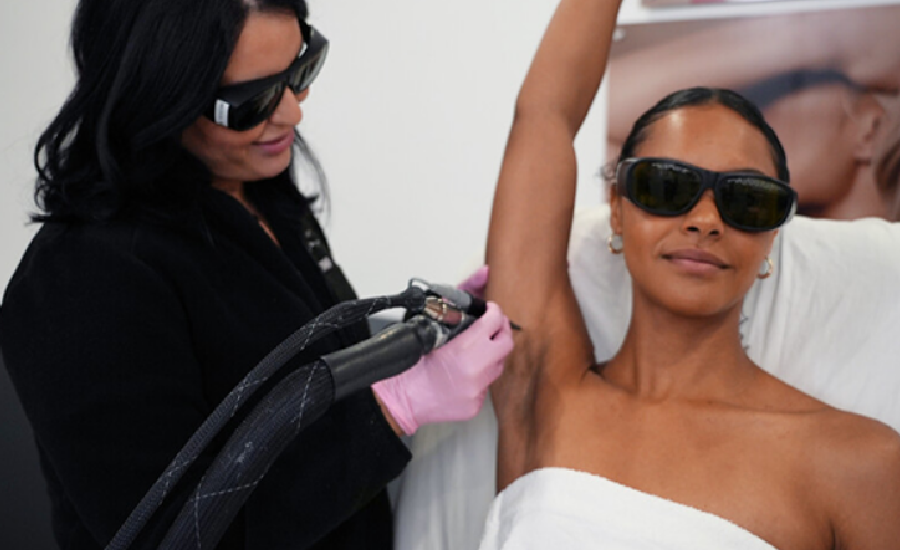Laser hair removal has quickly become one of the most popular and effective methods for long-term hair reduction, leaving shaving, waxing, and plucking far behind. With its increasing popularity, many myths and misconceptions about this procedure have emerged, leading to confusion and fear for potential clients.
Myth #1: Laser Hair Removal Is Extremely Painful
Fact:
While discomfort is a relative experience, most people describe the sensation of laser hair removal as tolerable. Many liken it to the feeling of a rubber band snapping on the skin.
For those particularly sensitive to pain, topical numbing creams can be applied before the treatment to minimize any discomfort. Laser hair removal is generally not considered a painful procedure when performed correctly.
Myth #2: Laser Hair Removal Only Works on Light Skin and Dark Hair
Fact:
This myth was accurate several years ago when early lasers had difficulty targeting darker pigments. However, advancements in technology have made it possible to perform effective laser hair removal on all skin types and hair colors.
For individuals with darker skin tones, there are specific laser systems (like Nd:YAG) that target hair follicles effectively, avoiding skin pigmentation. As for hair color, while it’s true that darker hair absorbs more energy for better results, some lasers can still work on lighter hair shades, though multiple sessions might be necessary for the best outcome.
Myth #3: Laser Hair Removal Provides Instant Results
Fact:
Laser hair removal is a process that requires a series of sessions over a period of time to achieve optimal results. Initially, hair may appear to be gone, but it’s important to understand that hair grows in cycles, and not all hair follicles are in the same growth phase when the treatment is performed.
Typically, 4-6 sessions spaced about 4-6 weeks apart are required to effectively target all hair follicles and achieve long-lasting results. After each session, the treated hairs will fall out, and with continued treatments, you’ll see a significant reduction in hair growth over time.
Myth #4: Laser Hair Removal Is Unsafe and Causes Scarring
Fact:
Laser hair removal, when performed by a trained and certified professional, is generally very safe and not associated with scarring. In fact, modern lasers are designed to minimize the risk of burns, scarring, and skin damage by targeting the hair follicles while leaving surrounding tissue unaffected.
However, improper treatment or the use of low-quality equipment can lead to potential complications. It’s crucial to choose a reputable clinic with trained experts who use FDA-approved, top-quality lasers for optimal safety and efficacy.
Myth #5: Laser Hair Removal Is Only for Women
Fact:
Laser hair removal is a highly effective solution for both men and women. Men often seek laser treatments for areas like the back, chest, and face, where unwanted hair growth can be a concern.
Laser technology is versatile, and many men also opt for treatments in smaller, more delicate areas, like the ears or the neckline. Whether it’s for personal grooming or comfort, laser hair removal is just as effective and beneficial for men as it is for women.
Myth #6: Laser Hair Removal Is Only for Face and Legs
Fact:
Another common misconception is that laser hair removal is only suitable for larger, more exposed areas like the face or legs. In reality, laser treatments can be safely used on a variety of areas, including the underarms, bikini line, back, chest, and even more sensitive areas such as the upper lip or chin.
In fact, many clients opt for bikini and Brazilian laser hair removal for more permanent results in those areas where shaving or waxing can be inconvenient.
Myth #7: Laser Hair Removal Is Extremely Expensive
Fact:
Laser hair removal might seem like a significant initial investment, but over time, it can save you money compared to other hair removal methods like shaving or waxing. Consider the ongoing costs associated with purchasing razors, creams, or booking waxing appointments, and you’ll find that laser hair removal often becomes more cost-effective in the long term.
Additionally, with a treatment plan tailored to your needs, the cost of laser hair removal has become more affordable as technology improves. Many clinics offer financing or package deals for multiple sessions, allowing you to spread the cost out.
Myth #8: Laser Hair Removal Is Only Effective on Thick Hair
Fact:
It’s a common belief that laser hair removal only works for thick, coarse hair, but the technology has advanced to treat finer hair as well. While thicker hair responds more quickly, fine or light-colored hair may still be treated successfully using modern techniques and lasers.
Since hair grows in different phases, consistency in treatment ensures that even finer hair can be targeted as it enters the active growth phase, reducing its visibility and preventing regrowth in the long term.
Myth #9: You Don’t Need to Care for Your Skin Post-Treatment
Fact:
Although laser hair removal itself doesn’t require extensive aftercare, some attention to your skin post-treatment can improve results and minimize any risk of irritation. The skin might appear red or inflamed immediately after the procedure, but this typically subsides within a few hours.
It’s recommended to avoid sun exposure and tanning beds for at least a few weeks after treatment, as the skin will be more sensitive. Using gentle moisturizers and applying SPF will help the skin heal properly, ensuring smooth and healthy skin post-procedure.
Myth #10: Laser Hair Removal Is Permanent
Fact:
While laser hair removal offers long-lasting results, it’s important to know that it is not considered “permanent” in the absolute sense. It significantly reduces hair growth, but some hair might regrow over time. For most people, hair regrowth is very fine and sparse, requiring only occasional touch-up treatments, usually once a year or as needed.
Maintaining results is easy, and laser treatments allow you to enjoy smooth skin for much longer than temporary methods like waxing or shaving.

